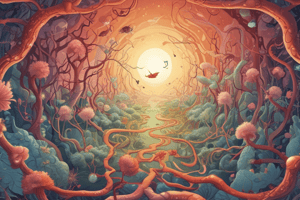Podcast
Questions and Answers
What is the study of the interactions between organisms and their environment?
What is the study of the interactions between organisms and their environment?
- Microbiology
- Botany
- Ecology (correct)
- Genetics
Which level of biological organization is composed of multiple tissues?
Which level of biological organization is composed of multiple tissues?
- Organs (correct)
- Organelles
- Cells
- Tissues
What is the process by which cells generate energy from glucose?
What is the process by which cells generate energy from glucose?
- Respiration (correct)
- Photosynthesis
- Metabolism
- Homeostasis
Flashcards are hidden until you start studying
Study Notes
What is Biology?
- Biology is the scientific study of life and living organisms
- It encompasses the structure, function, growth, evolution, distribution, and taxonomy of all living things
Branches of Biology
- Botany: study of plants
- Zoology: study of animals
- Microbiology: study of microorganisms
- Ecology: study of interactions between organisms and their environment
- Genetics: study of heredity and variation
- Biochemistry: study of chemical processes within living organisms
- Molecular Biology: study of biological molecules and their interactions
- Cell Biology: study of cell structure and function
Levels of Biological Organization
- Molecules: basic building blocks of life (e.g. DNA, proteins, carbohydrates)
- Organelles: specialized structures within cells (e.g. mitochondria, chloroplasts)
- Cells: basic units of life (e.g. prokaryotic, eukaryotic)
- Tissues: groups of similar cells (e.g. muscle, epithelial, connective)
- Organs: structures composed of multiple tissues (e.g. heart, brain, liver)
- Organ Systems: groups of organs that work together (e.g. circulatory, nervous, digestive)
- Organisms: individual living things (e.g. humans, plants, animals)
- Populations: groups of organisms of the same species
- Communities: groups of different species interacting with each other
- Ecosystems: communities and their physical environment
Biological Processes
- Metabolism: conversion of energy and nutrients within cells
- Photosynthesis: process by which plants convert light energy into chemical energy
- Respiration: process by which cells generate energy from glucose
- Homeostasis: maintenance of a stable internal environment
- Growth and Development: changes in size, shape, and complexity of organisms
- Evolution: change in species over time through genetic variation and natural selection
What is Biology?
- Biology is the scientific study of life and living organisms
- It encompasses the structure, function, growth, evolution, distribution, and taxonomy of all living things
Branches of Biology
- Botany is the study of plants
- Zoology is the study of animals
- Microbiology is the study of microorganisms
- Ecology is the study of interactions between organisms and their environment
- Genetics is the study of heredity and variation
- Biochemistry is the study of chemical processes within living organisms
- Molecular Biology is the study of biological molecules and their interactions
- Cell Biology is the study of cell structure and function
Levels of Biological Organization
- Molecules are the basic building blocks of life, including DNA, proteins, and carbohydrates
- Organelles are specialized structures within cells, such as mitochondria and chloroplasts
- Cells are the basic units of life, including prokaryotic and eukaryotic cells
- Tissues are groups of similar cells, such as muscle, epithelial, and connective tissues
- Organs are structures composed of multiple tissues, such as the heart, brain, and liver
- Organ Systems are groups of organs that work together, such as the circulatory, nervous, and digestive systems
- Organisms are individual living things, including humans, plants, and animals
- Populations are groups of organisms of the same species
- Communities are groups of different species interacting with each other
- Ecosystems are communities and their physical environment
Biological Processes
- Metabolism is the conversion of energy and nutrients within cells
- Photosynthesis is the process by which plants convert light energy into chemical energy
- Respiration is the process by which cells generate energy from glucose
- Homeostasis is the maintenance of a stable internal environment
- Growth and Development are changes in size, shape, and complexity of organisms
- Evolution is the change in species over time through genetic variation and natural selection
Studying That Suits You
Use AI to generate personalized quizzes and flashcards to suit your learning preferences.




